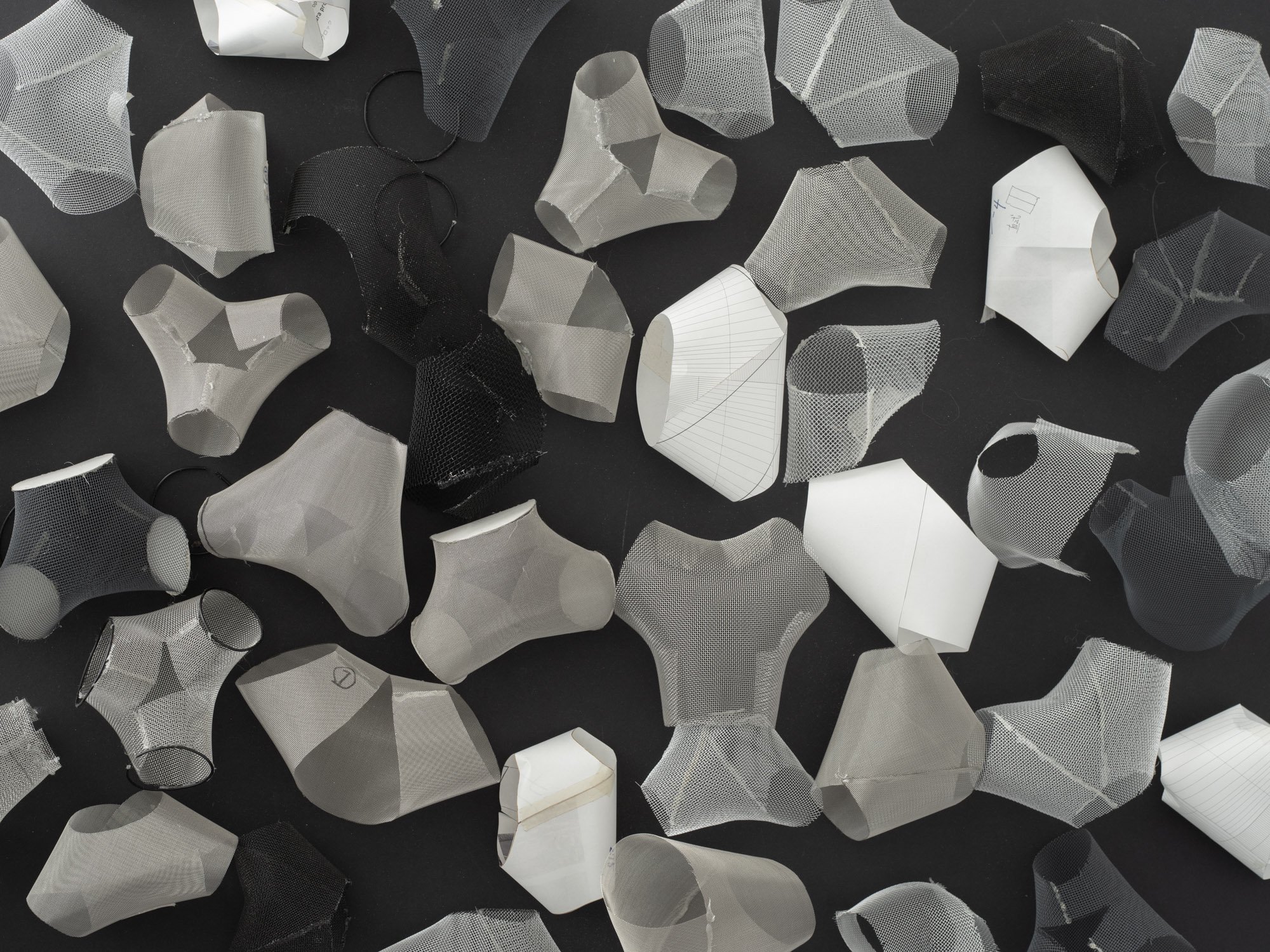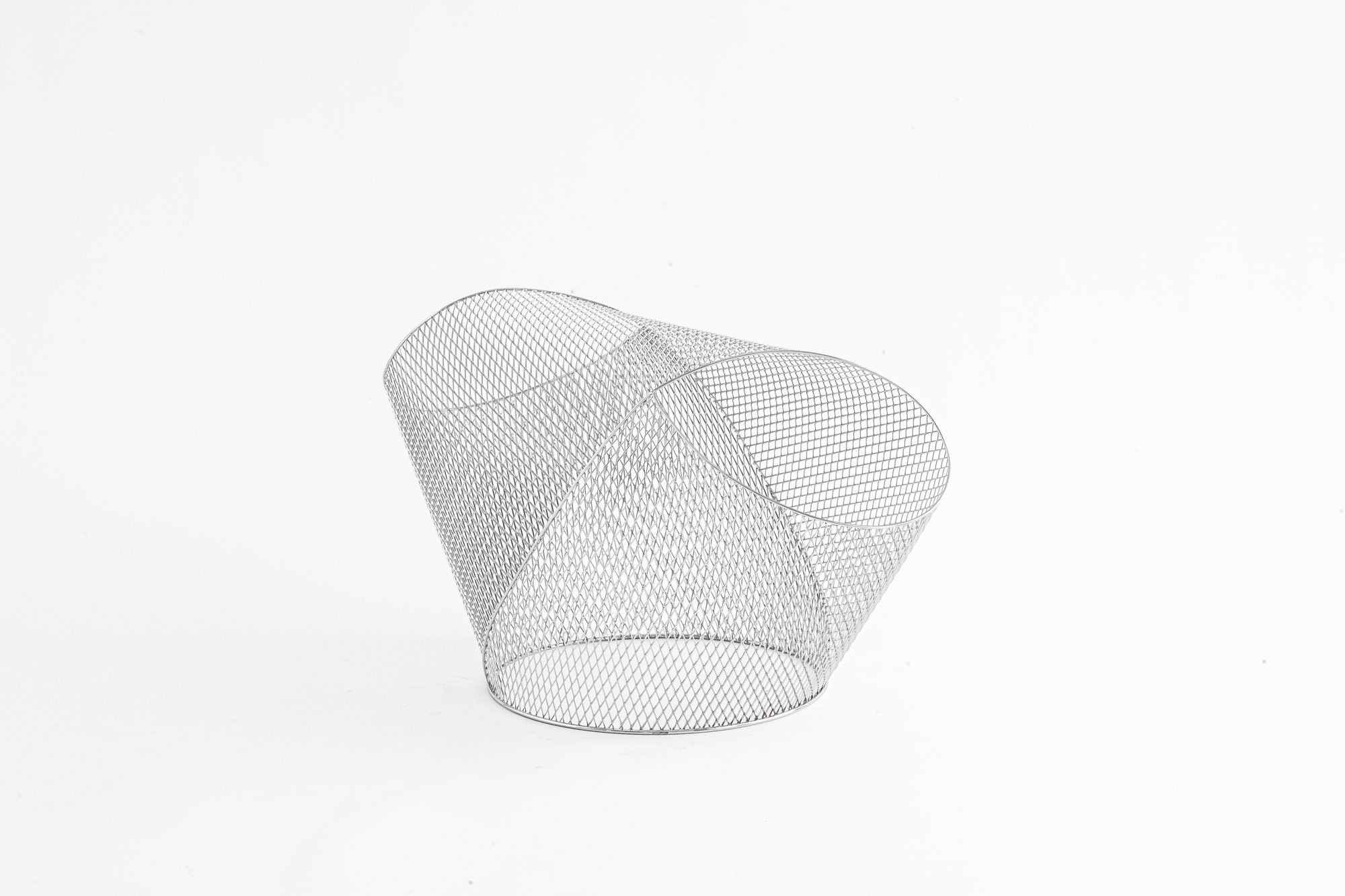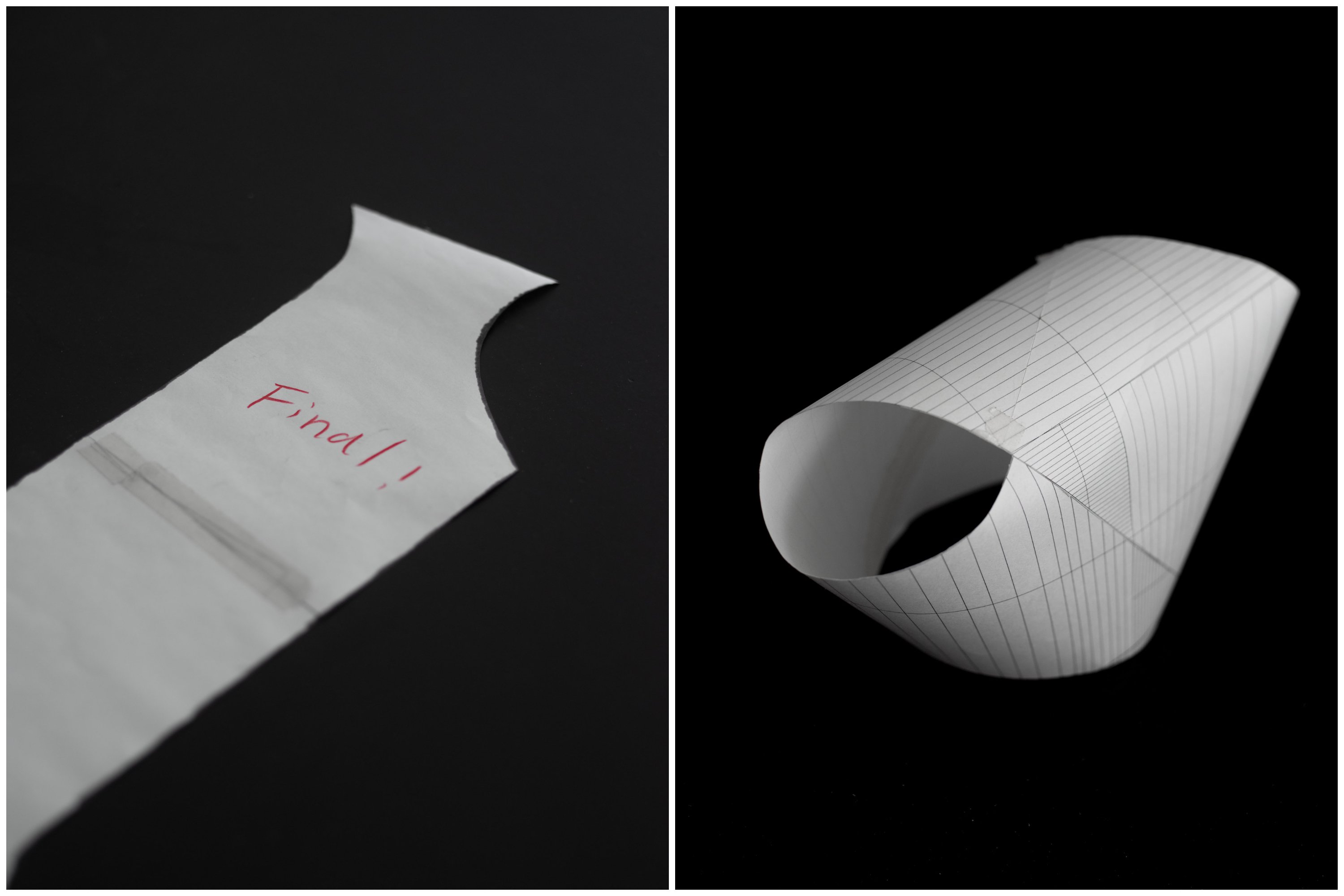
LICHT EDITION series
VOICE by Jin Kuramoto
20th Nov - 28th Nov 2021 at LICHT gallery
LICHTによるEDITIONシリーズの第二弾として、デザイナーの倉本仁による「VOICE」が発表されました。用途を前提とせずに手作業のトライアルを繰り返す中で偶発的に生まれたオブジェクトが持つ、唯一無二の存在感。そしてそれをプロダクトとして成立させてしまうデザイナーの力量に驚かされます。倉本さんに、この作品が生まれた背景や思いを聞きました。
たくさんの素材で作られた模型を拝見させていただきました。試行錯誤の痕跡を感じます。
倉本 : 7.8年くらいやっているんですよ。このプロジェクトは。30代半ばにさしかかってきたときに、手癖で仕事ができてしまうし、いろいろな関係性、求められるものも固まってきた。それをもう一回更新したいなと思ったときに「素材の声を聴く」というアプローチに辿り着いたんです。脳って、既存のものの編集は得意なんだけど、真に新しいものを作るのは苦手らしいんです。すると、なにかエポックメイキングなものを産むには「アクシデント」を起こすしかない。紙にスケッチをする行為って、結局ストックされたイメージの編集でしかない。だから、手で素材を触ることを僕は従来の”スケッチ”に置き換えているんです。いろんな素材を触って、丸めて、とやっていくと「素材がこっちに行きたがっているな」とわかるようになってきます。で、そうすると合理的な形が生まれる。入り口はあくまで素材の良さを十分に引き出すということ。そうしたら結果的に、スツールみたいなオブジェクトが仕上がりました。

偶発的な成果物とはいえ、そこにはプロダクトデザイナーなりの、もっとこうしたい、みたいな意識は入ってくるわけですよね。
倉本 : そうですね。なんとなく紙を丸めてハサミでチョキチョキ切って「こんな感じかなあ」なんて。モックを事務所に並べて、スタッフみんなで鑑賞しながら「これがいいよね」って。素材の取率もいいし、強度もある。とか、そのへんはまさに「プロダクトデザイナーらしさ」が抜け切っていないんですけど(笑)。
強度の話が出ましたが、このオブジェクトは用途不特定としつつも、スツールとして腰掛けることができます。
倉本 : (紙で作られたモックを手に)これなんて、丸めてくっつけているだけなんですけど、自然に生まれた張力で形作られている。それって構造計算的にも理にかなっていたりするんですよ。物理に立ち返ると、素材が一番力を発揮する形があるんです。僕はもともと携帯や車のインダストリアルデザイナーとしてキャリアを始めているんですが、プラスチックって、自分の思った線で自由に作れるんです。でも例えば建築(土木)だと、橋を見たときに、無駄なものがない。構造体として必要だから梁がある、みたいな。表裏がなくて上からも下からも見れる。車とか携帯のガワをデザインしてきたけど、中はブラックボックス、みたいなことはよくあって、自分は構造には関わっていなかったな、と。そういう経験があったから、素材独自の特性と構造の関係には強い関心があります。

倉本さんは様々なメーカーと一緒にプロダクトをデザインされています。ギャラリーから作品を発表することについて思いを聞かせてください。
倉本 : 実はこのプロジェクトの着地点が見えてきたときに、海外のギャラリーに見てもらおうかな、と思っていました。家具メーカーじゃなくて、やっぱり実験的なものに価値を見出してくれるようなデザインギャラリー。4年前にブリュッセルのギャラリーと家具を作ったことがあって、そのときに「こういうシーンがあるんだ」というのは体感していて。デザイナーがギャラリーから発表するものって、発信者と受け手の間に存在する思考のトレードがより濃く現れると思います。で、そんなときに旧知の中だった須摩さん(LICHTオーナー)から「こういう場所としてLICHTを作ったんだけど」と聞いて、すぐに手を取り合った(笑)。そこから発表するまでは随分と時間がかかったんですけど。僕は今回のアウトプットを”作品”と位置付けています。物事を販売するメーカーとの仕事ではどうしても「商いのために生まれてきたもの」という側面があるので、それを作品と呼ぶことには抵抗があり、製品・商品というニュアンスが存在する。あくまで僕の個人的な考えとしては、ですが。
発表元であるLICHTとの間で、どんなコミュニケーションがあったのでしょうか。
倉本 : 須摩さんは結構任せてくれるんですよ。やりたいようにやったらいい、と。それが一番怖いんですが。具体的なことでいうと、端面の処理がちょっと危ないかな、と思って相談したときも「気にしなくていいよ」と。だから、プレッシャーはありつつも、初期衝動のままやりきれた感じはありますね。自分の核を通すためにも、事務所のみんなのためにも、機会を与えてもらってありがたいなと。
ご自身の核を通す。反響が楽しみですね。これまでに発表されたプロダクトにも新たな視点から関心が集まりそうです。
倉本 : この手法(=手で様々な素材を触ってトライアルを繰り返すプロセス)を如実に体現しているこのプロジェクトは、事務所にきてくれる若いデザイナーにとっての教科書でもあるんですよ。インターンに来てくれている人にも、必ず皆にやってもらう。これが自分たちのやり方を一番表してるアプローチだから、って。だから、皆の顔が思い浮かんできます。ある種、集大成ですね(笑)。
倉本仁 (Jin Kuramoto)
家電メーカーのインハウスデザイナーを経て2008年にJin Kuramoto studioを設立。プロジェクトのコンセプトやストーリーを明快な造形表現で伝えるアプローチで、家具、家電製品、アイウェアから自動車まで多彩なジャンルのデザインに携わる。素材や材料を直に触りながら機能や構造の試行錯誤を繰り返す実践的な開発プロセスを重視し、プロトタイピングが行われている自身の”スタジオ”は常にインスピレーションと発見に満ちている。iF Design Award、Good Design賞、Red Dot Design Awardなど受賞多数。
LICHT EDITION第二弾「VOICE」by Jin Kuramoto
会期 : 2021年11月20日(土)-11月28日(日) 13:00-18:00 ※会期中は毎日営業
会場 : LICHT 東京都目黒区青葉台 3-18-10 2F
企画展概要はこちらをご覧ください。
VOICE" by designer Hitoshi Kuramoto is the second in the EDITION series by LICHT. I am amazed at the one-of-a-kind presence of the objects that were created accidentally through repeated manual trials without assuming their intended use. I was amazed at the designer's ability to turn them into products. We asked Mr. Kuramoto about the background and thoughts behind the creation of this work.
I had a chance to look at the models made of various materials. I can feel the traces of trial and error.
Kuramoto : I've been working on this project for about 7.8 years. When I was in my mid-thirties, I was able to work out of habit and had solidified various relationships and what was required of me. When I thought I wanted to update that once more, I arrived at the approach of "listening to the voice of the material. It seems that the brain is good at editing existing things, but not so good at creating something truly new. So, the only way to create something epoch-making is to create an accident. In the end, the act of sketching on paper is nothing more than editing stock images. That's why I replace the traditional "sketch" with the act of touching the material with my hands. As I touch various materials and roll them around, I start to understand that "the material wants to go this way. Then, a rational form is born. The first step is to bring out the best of the material. The result is an object that looks like a stool.

Even if it's an accidental product, the product designer's awareness of what he or she wants to do more of must come into play, right?
Kuramoto : That's right. I'd just roll up a piece of paper, cut it with scissors, and say, "I wonder if it looks like this. We'd lay the mock-ups out in the office and all the staff would look at them and say, "This is good. It's a good material, and it's strong. I'm still in the "product designer" phase, though (laughs).
As I mentioned strength, this object can be used as a stool for sitting on, even though its purpose is unspecified.
Kuramoto : (Holding a paper mockup in his hand) This one is just rolled up and stuck together, but it's formed by naturally occurring tension. It makes sense from a structural calculation point of view. If you go back to physics, there is a form in which the material can exert the most power. I originally started my career as an industrial designer for cell phones and cars, and with plastic, I can freely create whatever lines I want. But in architecture (civil engineering), for example, when you look at a bridge, there is nothing wasted. The beams are there because they are necessary for the structure. There is no front or back, and it can be seen from above or below. I've designed the guts of cars and cell phones, but the inside is often a black box, and I wasn't involved in the structure. Because of this experience, I have a strong interest in the relationship between the unique properties of materials and structure.

You design products with a variety of manufacturers. Please tell us about your thoughts on presenting your work through a gallery.
Kuramoto : Actually, I was thinking of having an overseas gallery take a look at my work when I started to see where this project would land. I had made furniture with a gallery in Brussels four years ago, and I knew from that experience that this kind of scene existed. I think that when a designer presents something from a gallery, the trade of thought that exists between the sender and the receiver becomes more intense. At that time, Suma-san (owner of LICHT), an old acquaintance of mine, told me that he had created LICHT as such a place, and we immediately joined hands (laughs). (laughs) It took a long time from then until I announced it. (laughs) It took a long time from then until I released it. When working with manufacturers who sell things, there is always the aspect of "something born for the sake of commerce," so I'm not comfortable calling it a work of art, and there is the nuance of a product or commodity. That's just my personal opinion, though.
What kind of communication did you have with LICHT, the publisher?
Kuramoto : Mr. Suma leaves a lot to me. He says I can do whatever I want. That's what scares me the most, though. For example, when I asked him for advice on an edge that I thought might be a little dangerous, he said, "Don't worry about it. So while I was under a lot of pressure, I felt like I was able to follow my initial impulse. I'm grateful to have been given this opportunity, both for the sake of my own core and for the sake of everyone at the office.
I'm looking forward to the response. I'm looking forward to seeing the response. The products you've released so far seem to be attracting interest from a new perspective.
Kuramoto : This project, which truly embodies this method (i.e., the process of touching various materials by hand and repeating trials), is also a textbook for the young designers who come to our office. I make sure to ask all the interns to do the same. They say, "This is the approach that best represents how we do things. So I can see everyone's face in my mind. It's kind of a culmination (laughs).
Jin Kuramoto
Established Jin Kuramoto studio in 2008 after working as an in-house designer for a consumer electronics manufacturer. With an approach that conveys the concept and story of a project through clear plastic expression, he has been involved in the design of a wide variety of genres, from furniture, home appliances, and eyewear to automobiles. His studio, where prototyping takes place, is always full of inspiration and discovery. He has received numerous awards including the iF Design Award, Good Design Award, and Red Dot Design Award.